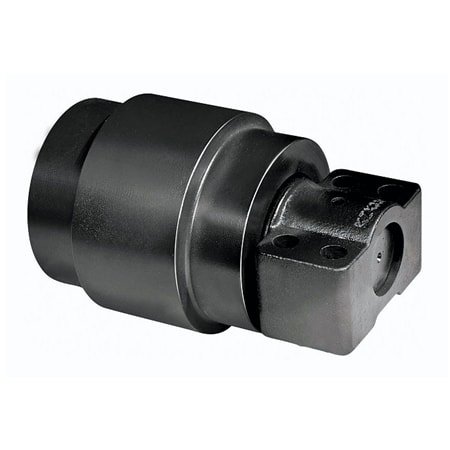Inspecting excavator carrier rollers for wear and damage is crucial for maintaining the equipment’s performance and safety.
Here’s how to conduct an inspection and the signs of potential issues to look for:
Inspection Steps:
- Visual Inspection: Begin with a visual examination of the carrier rollers. This includes inspecting the roller surface, mounting hardware, and the surrounding area.
- Check for Wear: Examine the surface of the carrier rollers for signs of wear. Look for flat spots, grooves, or irregularities in the roller’s profile.
- Bearing Condition: Check the condition of the roller’s bearings. Look for any signs of overheating, noise, or play in the bearings, which may indicate wear or damage.
- Alignment: Ensure that the carrier rollers are properly aligned with the track and the undercarriage components. Misalignment can lead to uneven wear.
- Mounting Hardware: Inspect the mounting hardware, such as bolts and brackets, to ensure they are securely fastened and in good condition. Loose or damaged hardware can cause issues.
- Lubrication: Check for proper lubrication of the carrier roller’s bearings. Inadequate lubrication can lead to premature wear.
Common Signs of Potential Issues:
- Excessive Wear: Signs of excessive wear on the roller’s surface may include flat spots, deep grooves, or irregularities in the roller profile.
- Bearing Noise: Unusual noises, such as grinding or squeaking, when the carrier roller is in motion can indicate problems with the bearings.
- Loose or Missing Hardware: If mounting hardware is loose, missing, or damaged, it can affect the stability and performance of the carrier roller.
- Misalignment: Carrier rollers that are not properly aligned with the track may exhibit uneven wear and reduced efficiency.
- Heat Buildup: Overheating of the bearings or the surrounding area may be a sign of excessive friction or a lack of proper lubrication.
- Excessive Play: If there is play or movement in the roller’s bearings, it may indicate wear and the need for replacement.
- Reduced Track Tension: Uneven wear on the carrier rollers can lead to track tension issues, affecting the machine’s stability and performance.
- Impact Damage: Physical impact or damage to the carrier roller can result in visible deformities or cracks.
- Uneven Wear: If some carrier rollers show more wear than others, it may suggest misalignment or issues with the undercarriage.
- Reduced Performance: A decrease in the excavator’s performance, such as slower speed or decreased maneuverability, can be a general indicator of issues with the undercarriage components, including carrier rollers.
If you identify any of these signs or issues during your inspection, it’s important to address them promptly. Regular maintenance and timely replacement of worn or damaged carrier rollers and related components are essential for ensuring the safety and efficiency of the excavator.
What materials are commonly used in the manufacturing of excavator carrier rollers, and why are these materials chosen?
Excavator carrier rollers are typically manufactured using durable materials that can withstand the demanding conditions of construction and excavation sites. Common materials used for excavator carrier rollers include:
- Steel: Steel is one of the most commonly used materials for excavator carrier rollers. It is known for its strength, durability, and resistance to wear. China HITACHI EX200-2 Excavator Undercarriage Part Carrier Roller High-quality steel, often alloyed with additional elements, is used to create strong and long-lasting carrier rollers. These rollers are capable of supporting the weight of the machine and maintaining stability on various terrains.
- Boron Steel: Boron steel, a type of high-strength steel, is used in some carrier rollers for enhanced hardness and wear resistance. Boron steel is particularly suitable for components exposed to heavy loads and abrasive conditions.
- Cast Iron: Cast iron carrier rollers are occasionally used in smaller excavators. Cast iron offers good wear resistance, but it is typically less common than steel due to its weight and cost.
- Polyurethane: In certain specialized applications, carrier rollers may have a polyurethane coating or segments. Polyurethane provides additional protection against wear and can reduce noise when the roller contacts the track chain.
- Aluminum: Some lightweight and compact excavators may use aluminum carrier rollers to reduce overall machine weight. Aluminum offers a balance between strength and weight savings.
The choice of materials depends on various factors, including the specific application, the size of the excavator, and the expected wear and load conditions. Steel is the most prevalent material due to its exceptional strength and wear resistance, making it suitable for heavy-duty construction equipment. Boron steel is often used for added hardness and longevity in high-wear applications.
The use of advanced manufacturing techniques and materials allows excavator carrier rollers to endure the harsh conditions and heavy loads they encounter during excavation and construction work, ensuring reliable performance and extended service life.
